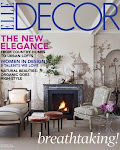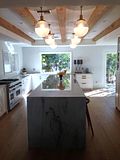I was at my local framer the other day (where I seem to be spending a lot of time recently.) The framer asked me about my approach to narrowing and selecting from all the options. I thought about it for a bit and have come up with the following: I search for a frame that complements but does not overpower the art. In my opinion, you want the art to be the focal point - to have the frame help draw the eye inwards to focus and highlight the piece. As a rule, I tend towards simple frame options. How do you pick a frame for your pieces without getting overwhelmed with the options?
skip to main |
skip to sidebar


This blog has a new home. You will be redirected shortly.
http://grantkgibson.com/blog
http://grantkgibson.com/blog
Blogger

"10 to watch"

"His work is always eclectic, livable, and easy on the eyes"
-Elle Decor
SUBSCRIBE
Diversions
All content, photos, images and text are the property of Grant K. Gibson unless otherwise credited. Nothing may be copied, altered, or reused in any way without prior written consent from Grant K. Gibson.










































































8 comments:
I try and go through mentally all my options beforehand that I think might work but then I also ask the framer to give me three differing options to what he thinks and also one complete wild card that I would never have even considered. But I do the process of framing things.
Depends on what I'm framing. If it's a landscape looking down a path or out to sea, a frame that starts high on the outside and leads in. Abstract smalls in watercolor a flatter frame. A lot of times I tell them I want something that looks like I found it in the attic. They are great- they combine matting & frames until I think it looks right.
embarrassed to say I once saw a frame sample so beautiful that I rushed home to find something to put it in. The framer thinking it a bit strange....the frame first, art second. That frame was art in itself
I'd call Grant Gibson:)
xo
First, I allow plenty of time to consider my options. My framer and I have worked together for years and together we usually come up with a great frame. But it is not only the frame: the mat and how the mat is detailed is very important. And above, all the frame and mat must be appropriate to the work being framed. It is definitely a process.
Mary
I really want the frame to support (and protect) the artwork and sometimes that means simple, and sometimes that means doing something really large to create a "space" around the artwork. Sometimes I even design my own frames. I adore beautiful frames and admire the work that goes into them, so it's always a treat to be able to use something different and have it work.
When I am really stumped I take the piece to Christine Lando to frame. She will really study the artwork, being an artist herself, and comes up with creative solutions for very difficult display problems.
I am fortunate to have access to a self-frame shop and have been doing my own framing for years. I also tend to steer away from large, overbearing gilded molding; opting instead for simple and classic. I like to use neutral matting and as thick as possible which gives the piece a true custom feel IMO. My favorite is a grey or ivory with a black layer underneath, so the black is revealed when the cut is made. Double matting is also best. In Europe, It is quite common to see the bottom portion of the mat a bit larger than the other 3 sides. The molding needs to be large enough to accommodate the glass and weight of the piece, though not too large. I select something appropriate to the piece which will emphasize not dominate.
Great topic.
best,
teaorwine
teaorwine.blogspot.com
I like to get odd and textured frames at TJ Maxx and then paint thin layers of iridescent colors over the cheap fake gold colors make it work with the artwork inside.
Post a Comment